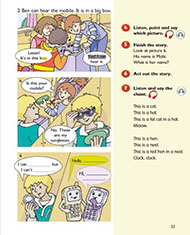
342 Lessons to English Mastery!
Macmillan English is a six-level Primary English course which meets the needs of today’s students. It recognises that proficiency in English is an essential part of modern life, and that early exposure to rich and genuine language allows young learners to move confidently towards native speaker fluency in both oral and written English.

ages 6+
(36 lessons)

ages 7+
(36 lessons)

ages 7+
(54 lessons)

ages 10+
(72 lessons)

ages 10+
(72 lessons)

ages 10+
(72 lessons)
Programme Features

Our Macmillan English units are delivered by highly trained teachers in an efficient and fun way.

Our Macmillan English curriculum is a story based reading and writing programme direct from the UK.

Macmillan English teaches the key skills of reading, comprehension, sentence and language building, grammar, listening, spelling and class writing.

All of our Macmillan English lessons are conversational based and your child will be fully immersed into the English language.

Alongside all of our lessons we also teach handwriting skills. Handwriting skills are essential and we devote a large amount of time to his vital aspect of the English language.
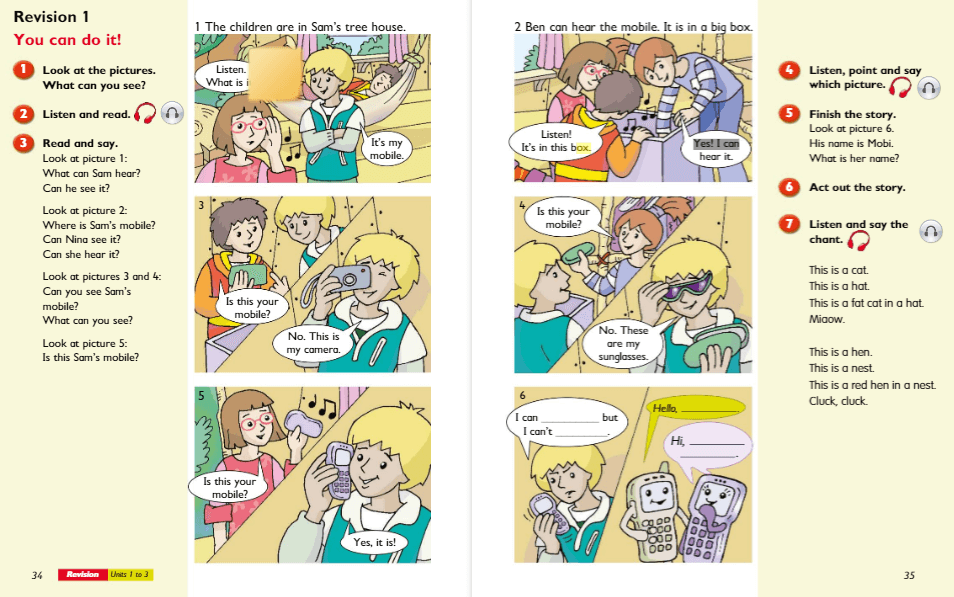
For Levels 1-3, your child will be tested every three units for reading comprehension and writing composition skills. For Levels 4-6, the assessment testing occurs every two units.
Course Materials
Each course or level includes three books:

Language Book contains the primary learning content and covers a two-page per unit reading portion; comprehension questions and activities based on the reading; sentence building, punctuation, and recognising parts of speech; grammar and listening for specific information, phonics, writing, and revisions.

Practice Book contains practice exercises for the Language Book activities. It is intended for students to complete for homework or for quiet class time. After every three Practice Book units is a two-page Check-up on grammar, punctuation and phonics, followed by two pages of general revision.

Fluency Book helps students to develop natural intonation in speaking English. It tells an exciting 18-episode adventure story featuring four child characters and uses some narrative, but mainly dialogue. The book is highly illustrated to engage young learners and provide stimulus for speaking.
Levels 1-3

Macmillan English 1 is for students who already speak some English and who are beginning to read and write.
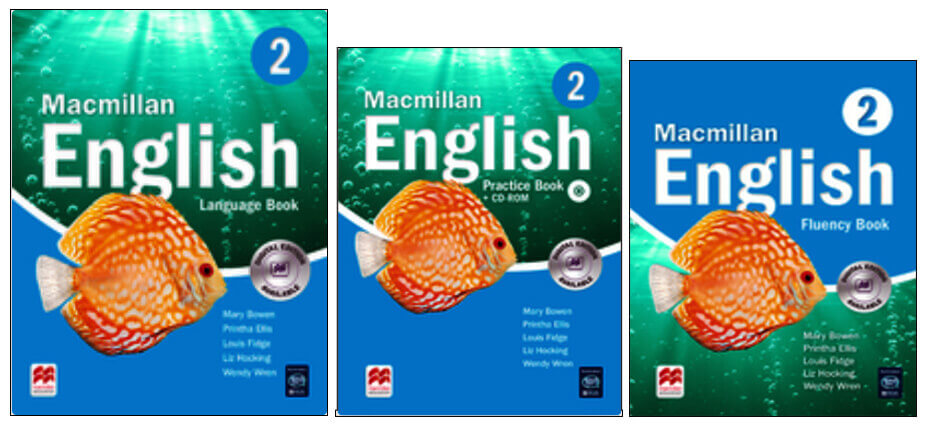
Macmillan English 2 is for students who already speak some English and who are beginning to read and write.
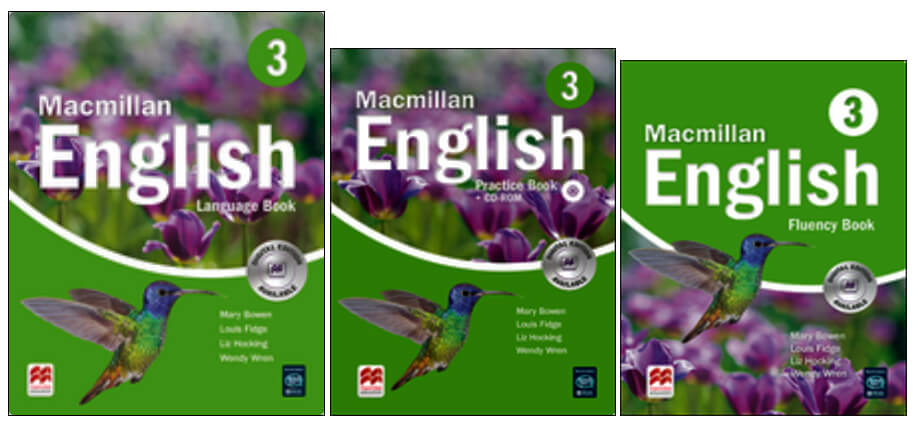
Macmillan English 3 is for students who are becoming confident oral communicators and more accurate readers and writers.
Each of the 18 units within Levels 1-3 of Macmillan English is taught in three lessons:
Lesson 1: reading fluency and comprehension
Students look at the large poster picture first and ask questions, saying as much as possible about the poster. Then they listen to a recorded episode and follow events illustrated on the poster. The teachers asks questions about the story and dialogue to check comprehension. Students are given the chance to work in groups or teams and to practice language actively.
Lesson 2: grammar skills and sentence structure
Example structures are presented using characters from the fluency book story so that students are reminded of the context for the language. The presentation of the grammar page gives a clear model to refer back to.
Written English skills are presented in clear terms with examples. Each rule provides a foundation of accurate writing and and apply at even the most basic level.
Lesson 3: listening and writing composition
Listening activities reinforce the structures and vocabulary for the unit and help students to develop their aural skills.
Using the stimulus material in the Language Book, the teacher guides the class towards producing model language. The teacher elicits sentences from students and writes them on the board and has the class read them together. This serves as a framework for the individual work they will do in their writing books.



Levels 4-6
Macmillan English 4, 5 and 6 courses are high level courses, however our teachers deliver them in a fun and meaningful way. Students are taught to apply their knowledge to the world they live in. We expect our older students to think for themselves, question all that is around them and make informed decisions about their studies.

Macmillan English 4 is for students who are ready to use carefully selected and supported authentic materials, and to develop their reading and writing skills.

Macmillan English 5 is for students who are becoming confident oral communicators and more accurate readers and writers.

Macmillan English 6 is for students who are becoming confident oral communicators and more accurate readers and writers.
Each of the 18 units within Levels 4-6 of Macmillan English is taught in four lessons:
Lesson 1
reading
Students read two pages presented in the style of an authentic children’s book. Each unit presents a different text type such as an extract from a short story, a poem, a playscript or a non-fiction text. Students look at the poster picture first and ask questions saying as much as possible about the poster. Then they listen to a recorded episode and follow events illustrated on the poster. The teacher asks questions about the story and dialogue to check comprehension. Students are given the chance to work in small groups, pairs or individually.
Lesson 2
listening
Students are introduced to a student radio station called “Let’s Go,” in the form of a highly illustrated magazine format. Student radio station presenters and reporters travel around the world visiting different countries and interesting places. The reporters then talk about their experiences meeting different people, learning about new cultures and trying exciting activities. Students write answers to questions based on the report in real time, noting down answers as soon as they hear them.
Lesson 3
grammar
The specific structure for the unit already seen in the reading text is explained in detail and taught through reading, writing and speaking activities. Students are taught a wide range of grammar concepts in a way that is easily understood, and clear contextual examples are provided from the story lesson the week before. Areas covered range from abstract nouns to active and passive sentences to specific names of verb tenses and beyond, all learnt within the context of a familiar text.
Lesson 4
writing
Students first complete a writing task together, led and guided by the teacher as ‘shared writing.’ The task follows the form and style of the reading text for the unit and begins to develop the skill of choosing the appropriate writing style for different purposes. Students are encouraged to use grammar structures practiced from the previous week and to apply correct punctuation and spelling wherever possible. Students are then given a similar writing task to tackle independently at home for extra reinforcement and practice.




342 Lessons to English Mastery!
Macmillan English is a six-level Primary English course which meets the needs of today’s students. It recognises that proficiency in English is an essential part of modern life, and that early exposure to rich and genuine language allows young learners to move confidently towards native speaker fluency in both oral and written English.

ages 6+
(36 lessons)

ages 7+
(36 lessons)

ages 7+
(54 lessons)

ages 10+
(72 lessons)

ages 10+
(72 lessons)

ages 10+
(72 lessons)
Programme Features
Our Macmillan English units are delivered by highly trained teachers in an efficient and fun way.
Our Macmillan English curriculum is a story based reading and writing programme direct from the UK.
Macmillan English teaches the key skills of reading, comprehension, sentence and language building, grammar, listening, spelling and class writing.

All of our Macmillan English lessons are conversational based and your child will be fully immersed into the English language.
Alongside all of our lessons we also teach handwriting skills. Handwriting skills are essential and we devote a large amount of time to this vital aspect of the English language.
Course Materials
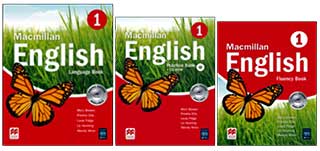
Each course or level includes three books:
Language Book contains the primary learning content and covers a two-page per unit reading portion; comprehension questions and activities based on the reading; sentence building, punctuation, and recognising parts of speech; grammar and listening for specific information, phonics, writing, and revisions.
Practice Book contains practice exercises for the Language Book activities. It is intended for students to complete for homework or for quiet class time. After every three Practice Book units is a two-page Check-up on grammar, punctuation and phonics, followed by two pages of general revision.
Fluency Book helps students to develop natural intonation in speaking English. It tells an exciting 18-episode adventure story featuring four child characters and uses some narrative, but mainly dialogue. The book is highly illustrated to engage young learners and provide stimulus for speaking.
Levels 1-3
Macmillan English 1

ages 6+
(36 lessons)
This level is for students who already speak some English and who are beginning to read and write.
Macmillan English 2

ages 7+
(36 lessons)
This level is for students who already speak some English and who are beginning to read and write.
Macmillan English 3

ages 7+
(54 lessons)
Macmillan English 3 is for students who are becoming confident oral communicators and more accurate readers and writers.
Each of the 18 units within Levels 1-3 of Macmillan English is taught in three lessons:
Lesson 1: reading fluency and comprehension
Students look at the large poster picture first and ask questions, saying as much as possible about the poster. Then they listen to a recorded episode and follow events illustrated on the poster. The teachers asks questions about the story and dialogue to check comprehension. Students are given the chance to work in groups or teams and to practice language actively.
Lesson 2: grammar skills and sentence structure
Example structures are presented using characters from the fluency book story so that students are reminded of the context for the language. The presentation of the grammar page gives a clear model to refer back to.
Written English skills are presented in clear terms with examples. Each rule provides a foundation of accurate writing and and apply at even the most basic level.
Lesson 3: listening and writing composition
Listening activities reinforce the structures and vocabulary for the unit and help students to develop their aural skills.
Using the stimulus material in the Language Book, the teacher guides the class towards producing model language. The teacher elicits sentences from students and writes them on the board and has the class read them together. This serves as a framework for the individual work they will do in their writing books.
Levels 4-6
Macmillan English 4, 5 and 6 courses are high level courses, however our teachers deliver them in a fun and meaningful way. Students are taught to apply their knowledge to the world they live in. We expect our older students to think for themselves, question all that is around them and make informed decisions about their studies.
Macmillan English 4

ages 6+
(36 lessons)
This level is for students who are ready to use carefully selected and supported authentic materials, and to develop their reading and writing skills.
Macmillan English 5

ages 6+
(36 lessons)
This level is for students who are becoming confident oral communicators and more accurate readers and writers.
Macmillan English 6

ages 6+
(36 lessons)
This level is for students who are becoming confident oral communicators and more accurate readers and writers.
Each of the 18 units within Levels 4-6 of Macmillan English is taught in four lessons:
Lesson 1
reading
Students read two pages presented in the style of an authentic children’s book. Each unit presents a different text type such as an extract from a short story, a poem, a playscript or a non-fiction text. Students look at the poster picture first and ask questions saying as much as possible about the poster. Then they listen to a recorded episode and follow events illustrated on the poster. The teacher asks questions about the story and dialogue to check comprehension. Students are given the chance to work in small groups, pairs or individually.
Lesson 2
listening
Students are introduced to a student radio station called “Let’s Go,” in the form of a highly illustrated magazine format. Student radio station presenters and reporters travel around the world visiting different countries and interesting places. The reporters then talk about their experiences meeting different people, learning about new cultures and trying exciting activities. Students write answers to questions based on the report in real time, noting down answers as soon as they hear them.
Lesson 3
grammar
The specific structure for the unit already seen in the reading text is explained in detail and taught through reading, writing and speaking activities. Students are taught a wide range of grammar concepts in a way that is easily understood, and clear contextual examples are provided from the story lesson the week before. Areas covered range from abstract nouns to active and passive sentences to specific names of verb tenses and beyond, all learnt within the context of a familiar text.
Lesson 4
writing
Students first complete a writing task together, led and guided by the teacher as ‘shared writing.’ The task follows the form and style of the reading text for the unit and begins to develop the skill of choosing the appropriate writing style for different purposes. Students are encouraged to use grammar structures practiced from the previous week and to apply correct punctuation and spelling wherever possible. Students are then given a similar writing task to tackle independently at home for extra reinforcement and practice.
